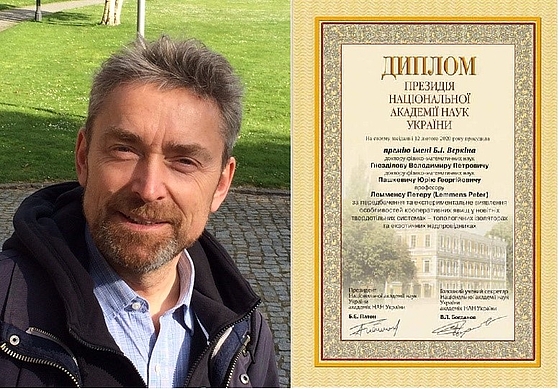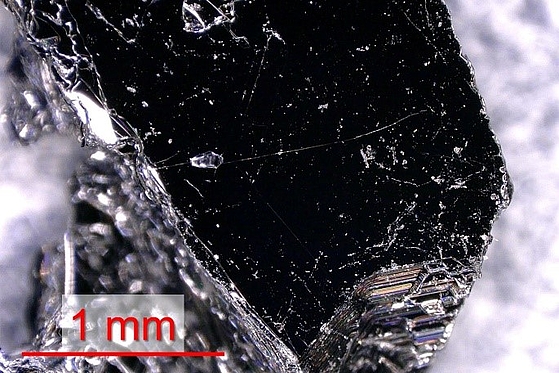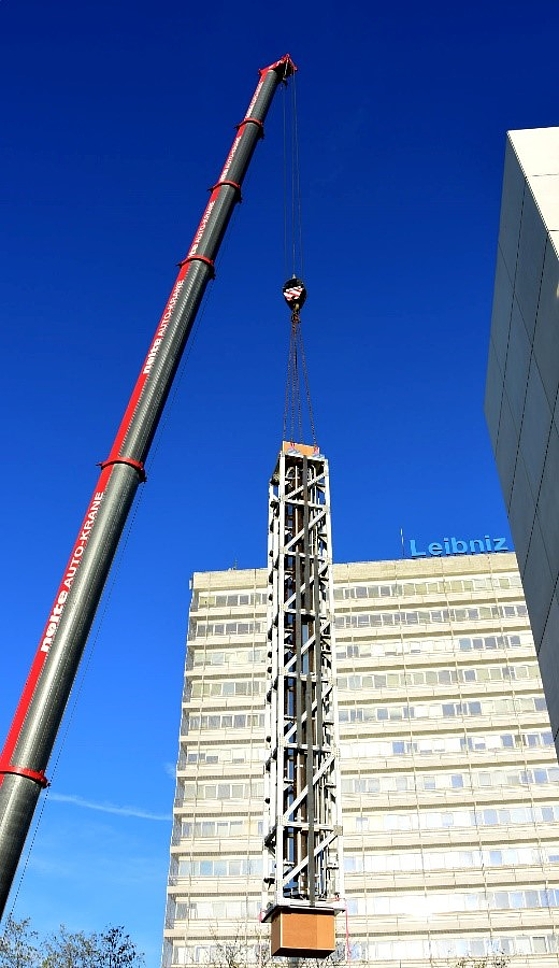QuantumFrontiers Newsletter #04 (May 2020)
News
B. I. Verkin-Preis des Jahres 2020 der Akademie der Wissenschaften der Ukraine (NAS) an Peter Lemmens und ukrainische Kollegen
Herzlichen Glückwunsch an Professor Peter Lemmens! Der Leiter des Instituts für Physik der Kondensierten Materie hat gemeinsam mit zwei ukrainischen Kollegen den B. I. Verkin Preis erhalten. Das Präsidium der Akademie der Wissenschaften der Ukraine verlieh die Auszeichnung für die herausragende Arbeiten zur Vorhersage und experimentellen Detektion kooperativer Phänomene in neuesten Festkörpersystemen, topologischen Isolatoren und exotischen Supraleitern. 20 Jahre lang arbeite die drei nun bereits zusammen und haben über 50 gemeinsame Publikationen verfasst.

|
Magnon bound states versus anyonic Majorana excitations in the Kitaev honeycomb magnet α-RuCl3
Einem Team von Wissenschaftlerinnen und Wissenschaftlern aus Braunschweig, Korea und Frankreich gelang es, einen neuartigen Quantenzustand zu erzeugen und nachzuweisen. Dieser Zustand zeichnet sich durch seine ungewöhnlichen Anregungen aus, die einen „gebrochenen“, fraktionalen Charakter besitzen. Die Forschungsarbeiten wurden im Rahmen des Exzellenzclusters QuantumFrontiers und im Metrologie-Forschungsschwerpunkt an der TU Braunschweig unterstützt sowie von der Deutschen Forschungsgemeinschaft (DFG) gefördert.
Die Ergebnisse sind im Magazin „Nature Communications“ erschienen. Die Experimente wurden im November 2018 in Paris an der Université Diderot-Paris, und im Mai 2019 im Hochmagnetfeldlabor Grenoble durchgeführt. Darüber hinaus besteht eine intensive Zusammenarbeit mit der koreanischen Gruppe seit über zehn Jahren.

|
A scalable high-performance magnetic shield for very long baseline atom interferometry
Light-pulse atom interferometry is a key technique of modern quantum sensing. It provides state-of-the-art determinations of fundamental constants, ways to search for new physics, and promises a novel era in inertial sensing, in particular gravimetry and gravity-gradiometry. Due to the quadratic scaling of the interferometric phase with the atomic free-fall time, an essential parameter to increase the sensitivity of atomic gravimeters is to increase the distance travelled by the atoms in the interferometer. This naturally motivates the quest for very long baseline atom interferometry, where the free-fall baseline extends over several meters instead of tens of centimetres for more conventional devices. This is also useful for other applications of atom interferometry such as testing the universality of free-fall, measuring gravitational redshift, and developing new atom-optics techniques for spaceborne missions.
The Hannover Very Long Baseline Atom Interferometry (VLBAI) facility is one of the three major research equipment of the Hannover Institute of Technology (HITec). It is a novel 10 m-scale atom interferometer designed with state-of-the-art performance in mind. Among the most crucial engineering challenges is the control of magnetic fields along the interferometry baseline. Any gradient can produce bias accelerations on the atoms and thus increase the instrument's inaccuracy.
In collaboration with the group of Peter Fierlinger (TUM) and the Swiss magnetic shielding specialists at IMEDCO AG (Hägendorf), we developed, characterized, and installed a 10 m-long magnetic shield for our VLBAI facility. It features residual fields below 5 nT over eight meters, with gradients not larger than 2 nT/m. This corresponds to measurement biases below 5e-14 m/s², fully compatible with our goals within QuantumFrontiers and a step ahead of the international competition.
For more information, please consult the associated research article. Questions, as well as thesis inquiries, can be addressed to Dennis Schlippert (schlippert@iqo.uni-hannover.de).

|
Relativistic geoid: Gravity potential and relativistic effects
The Earth's geoid is one of the most essential and fundamental concepts to provide a gravity field-related height reference in geodesy and associated sciences. To keep up with the ever-increasing experimental capabilities and to consistently interpret high-precision measurements without any doubt, a relativistic treatment of geodetic notions within Einstein's theory is inevitable. In contrast to the Newtonian situation, in which the gravity field is described by a single scalar potential, the relativistic scenario has many more degrees of freedom. They can be decomposed and also reduced in special situations.
Assuming the Earth is stationary over timescales larger than the observational period of a geodetic measurement, we construct a rigid general relativistic model. Building on the theoretical construction of isochronometric surfaces and the so-called redshift potential for clock comparison, a relativistic gravity potential as a generalization of (post-)Newtonian notions is defined. It can be proven, that this potential is the same as realized by local plumb lines. Hence, clock comparison and gravimetric observations can be used for its determination in data fusion. In the weak-field limit, the well-known and familiar Newtonian gravity potential is recovered.
In a second step, we employ this gravity potential to define the relativistic geoid in direct analogy to the Newtonian understanding. For a better illustration and proper interpretation of the concepts, some particular examples are considered. Comparing the Earth's Newtonian geoid to its relativistic generalization is a very subtle problem, but of high interest. An isometric embedding into Euclidean three-dimensional space is an appropriate solution and allows a genuinely intrinsic comparison free of coordinate ambiguities. With this method, the mean leading-order difference is determined, which is about 2mm.
The results obtained so far pave the way towards a general relativistic formulation of (chronometric) geodesy on Earth and in space. Clock networks and high-precision (atom) interferometry in gravimeters will be the experimental cornerstone of future relativistic geodesy. Besides the geoid, also other geodetic concepts have to be generalized and new observables need to be defined to construct a consistent and useful observation-related framework.

|
Recent publications
Alves J G, Fantuzzi E, Rühm W, Gilvin P, Vargas A, Tanner R, Rabus H, Lopez M A, Breustedt B, Harrison R, Stolarczyk L, Fattibene P, Woda C, Caresana M, Knežević Ž, Bottollier-Depois J F, Clairand I, Mayer S, Miljanic S, Olko P, Schuhmacher H, Stadtmann H, Vanhavere F (2019-12) EURADOS education and training activities. Journal of Radiological Protection 39:R37–R50.
Bautista-Salvador A, Zarantonello G, Hahn H, Preciado-Grijalva A, Morgner J, Wahnschaffe M, Ospelkaus C (2019-04) Multilayer ion trap technology for scalable quantum computing and quantum simulation. New Journal of Physics 21:43011.
Bornemann S, Yulianto N, Spende H, Herbani Y, Prades J D, Wasisto H S, Waag A (2020-02) Femtosecond Laser Lift‐Off with Sub‐Bandgap Excitation for Production of Free‐Standing GaN Light‐Emitting Diode Chips. Advanced Engineering Materials 22:1901192.
Koke S, Kuhl A, Waterholter T, Raupach S M F, Lopez O, Cantin E, Quintin N, Amy-Klein A, Pottie P-E, Grosche G (2019-10) Combining fiber Brillouin amplification with a repeater laser station for fiber-based optical frequency dissemination over 1400 km. New Journal of Physics 21:123017.
Loriani S, Schlippert D, Schubert C, Abend S, Ahlers H, Ertmer W, Rudolph J, Hogan J M, Kasevich M A, Rasel E M, Gaaloul N (2019-06) Atomic source selection in space-borne gravitational wave detection. New Journal of Physics 21:63030.
Maksimov A A, Filatov E V, Tartakovskii I I, Yakovlev D R, Waag A (2019-12) Direct Measurements of the Picosecond Kinetics of Heating of a Spin Subsystem in Semimagnetic Semiconducting Nanostructures. JETP Letters 110:799–803.
Philipp D, Hackmann E, Lämmerzahl C, Müller J (2020-03) Relativistic geoid: Gravity potential and relativistic effects. Physical Review D 101:64032.
Schweiger C, König C M, Crespo López-Urrutia J R, Door M, Dorrer H, Düllmann C E, Eliseev S, Filianin P, Huang W, Kromer K, Micke P, Müller M, Renisch D, Rischka A, Schüssler R X, Blaum K (2019-12) Production of highly charged ions of rare species by laser-induced desorption inside an electron beam ion trap. Review of Scientific Instruments 90:123201.
Voges K K, Gersema P, Hartmann T, Schulze T A, Zenesini A, Ospelkaus S (2019-12) A pathway to ultracold bosonic 23 Na 39 K ground state molecules. New Journal of Physics 21:123034.
Frombach D, Recher P (2019-11-06) Quasiparticle poisoning effects on the dynamics of topological Josephson junctions. Physical Review B 101:
Schuray A, Frombach D, Park S, Recher P (2019-11-22) Transport signatures of Majorana bound states in superconducting hybrid structures. The European Physical Journal Special Topics 229:593–620.
Krieg L, Zhang Z, Splith D, Wenckstern H v, Grundmann M, Wang X, Gleason K K, Voss T (2020-04) Controlled formation of Schottky diodes on n-doped ZnO layers by deposition of p-conductive polymer layers with oxidative chemical vapor deposition. Nano Express 1:10013.
Wulferding D, Choi Y, Do S-H, Lee C H, Lemmens P, Faugeras C, Gallais Y, Choi K-Y (2020-03) Magnon bound states versus anyonic Majorana excitations in the Kitaev honeycomb magnet α-RuCl3. Nature Communications 11
Wodey E, Tell D, Rasel E M, Schlippert D, Baur R, Kissling U, Kölliker B, Lorenz M, Marrer M, Schläpfer U, Widmer M, Ufrecht C, Stuiber S, Fierlinger P (2020-03) A scalable high-performance magnetic shield for very long baseline atom interferometry. Review of Scientific Instruments 91:35117.
Cardarelli L, Greschner S, Santos L (2020-03) Deconfining Disordered Phase in Two-Dimensional Quantum Link Models. Physical Review Letters 124
Freise L, Gerster T, Reifert D, Weimann T, Pierz K, Hohls F, Ubbelohde N (2020-03) Trapping and Counting Ballistic Nonequilibrium Electrons. Physical Review Letters 124
New on arXiv from QuantumFrontiers
Bruns F F, Vyatchanin S P, Dickmann J, Glaser R, Heinert D, Nawrodt R, Kroker S (2020-03-11) Thermal charge carrier driven noise in transmissive semiconductor optics
L. Schulz S A, Peshkov A A, Müller R A, Lange R, Huntemann N, Tamm C, Peik E, Surzhykov A (2020-03-06) Generalized excitation of atomic multipole transitions by twisted light modes
Funding opportunities
Internal: New round of Flexible Fund proposals
The next Science Board Meeting is scheduled for Thursday, June 18th, 2020.
Accordingly, the new deadlines for Flexible Funds proposals are:
Proposals > 50.000€: Thursday, 04.06.2020
Proposals < 50.000€: Thursday, 11.06.2020
IMPORTANT: Please remember that a Flexible Fund proposal must be assigned to a Research Unit or a Topical Group for submission. The respective Unit/Group leader will act as rapporteur in case the proposal amounts to more than 50k€. If your proposals affect several Units/Groups, please choose your primary one. Refer to our wiki for guidelines and templates.
Other Events
Exclusive Offers for PostDocs - Neues Postdoc-Programm der TUBS
For PostDocs, TUBS offers exclusive workshops as well as networking and coaching opportunities. The offers are designed according to your needs with concrete challenges around the PostDoc career phase. The offers for PostDocs are all in the English language.
Open Positions
PTB PhD Projekte
Wir haben drei Doktorandenstellen auf dem Gebiet der Quantenlogik-Spektroskopie anzubieten (85% E13 TVöD)
Quantenlogikspektroskopie ist die Anwendung von Methoden der Quanteninformationsverarbeitung in der Spektroskopie. Sie ermöglicht die spektroskopische Untersuchung von Spezies, die sich herkömmlichen Methoden entziehen, wodurch sich eine enorme Bandbreite neuer Spezies für die modernsten Werkzeuge der optischen Präzisionsmetrologie öffnet. Die ausgeschriebene Stelle befasst sich mit der Untersuchung einer der folgenden Systeme: - Aluminiumionen für die Realisierung einer hochgenauen optischen Uhr (S. Hannig et al. Rev. Sci. Instrum. 90, 053204 (2019))
- Molekülionen, z.B O2+ für den Nachweis einer möglichen Variation von Fundamentalkonstanten (Wolf et al., Nature 530, 457, (2016))
- Hochgeladenen Ionen, z.B. Ca14+ für neue optische Uhren und Tests fundamentaler Physik (Micke et al. Nature 578, 60 (2020))
Für weitere Informationen wenden Sie sich an Piet O. Schmidt (piet.schmidt@quantummetrology.de) oder besuchen Sie unsere Homepage
Positions in the field of Quantum Optomechanics
Within Research Unit A4 we are offering PhD and PostDoc positions in the fascinating and very active field of Quantum Optomechanics. We are specifically looking for candidates with a background in theoretical and/or experimental Quantum Optics who are interested in research at the intersection of Quantum Physics and the physics of Gravitational Wave Detectors, and who want to contribute to our ongoing research projects in these fields.
For further information please contact Prof. Michèle Heurs (Email: michele.heurs@aei.uni-hannover.de) and Klemens Hammerer (Email: klemens.hammerer@itp.uni-hannover.de).
Research Assistant (PhD) in experimental physics
The Institute of Quantum Optics invites applications for the position of a Research Assistant (PhD Student, m/f/d) in experimental physics (Salary Scale 13 TV-L, 75 %) starting in the near term. The position is limited to 3 years.
Bose-Einstein condensates (BECs) consist of indistinguishable atoms, which occupy the same quantum state – just as a laser beam consists of indistinguishable photons. The Quantum Atom Optics group at the Institute of Quantum Optics, led by apl. Prof. Dr. Carsten Klempt, generates highly entangled atomic states in BECs for fundamental quantum optics experiments and precision measurements. In the framework of this project, the group offers a PhD position. The objective of the thesis is the generation of Schrödinger cat states in BECs.
For further information, please contact apl. Prof. Carsten Klempt (Email: klempt@iqo.uni-hannover.de)
|